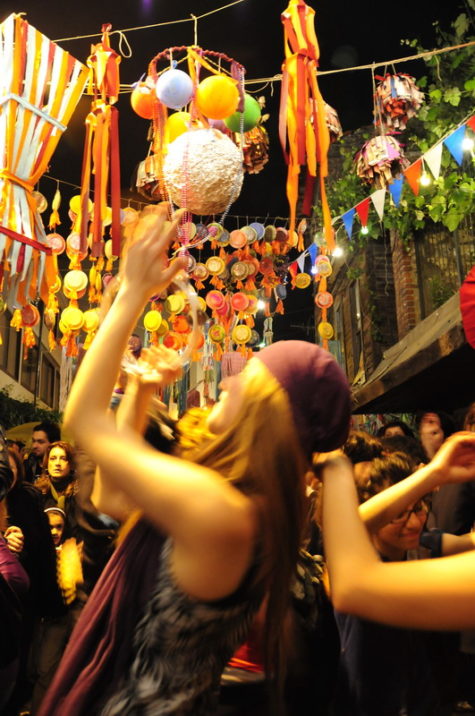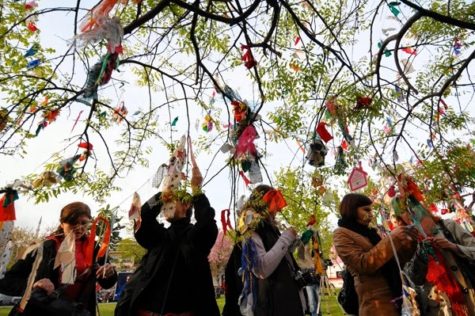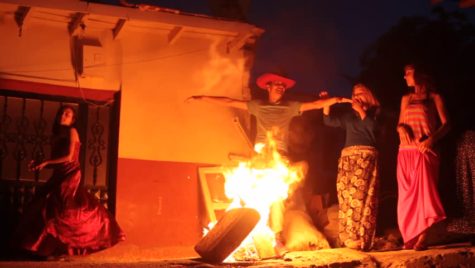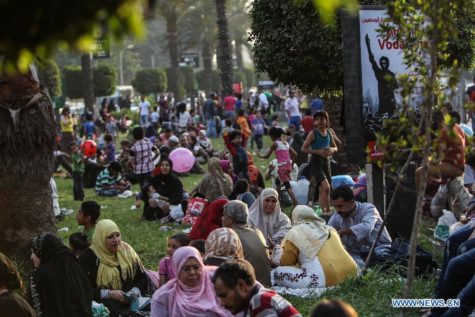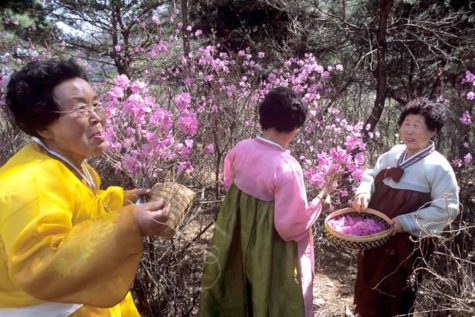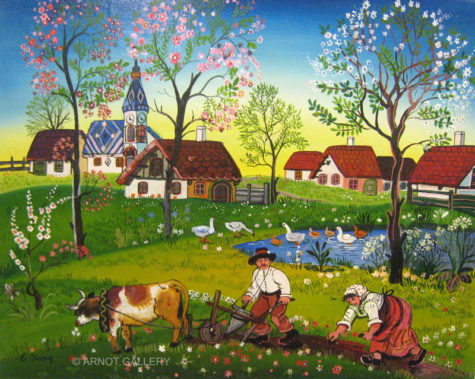Spring Festivals
Baking is appropriate for celebrating Imbolc, and we often make Crescent cakes for the end of our Imbolc ritual. Here is our circle’s favorite recipe:
- 1 1/4 cups Flour
- 3/4 cup Sugar
- 1 cup Finely Ground Almonds
- 3 drops Almond Extract
- 1/2 cup Butter or Margarine, softened
- 1 tablespoon Honey
- 1 Egg Yolk
In a large mixing bowl, combine the first four ingredients. Add the butter, honey and egg yolk and mix together well. Cover with aluminum foil or plastic wrap, and then chill for 1 1/2 to 2 hours in the refrigerator.
When ready, pinch off pieces of the dough (about the size of plums) and shape them into crescents. Place the crescents on a well-greased cookie sheet and bake in a 325-degree preheated oven for approximately 20 minutes. This recipe yields 20 to 25 crescents.
From Rose Ariadne
Đurđevdan is a major holiday for Roma from former Yugoslavia, whether Orthodox or Muslim. The various Balkan spellings (Herdeljez, Erdelezi) are variants of the Turkish Hıdırellez.
Ederlezi is the Gypsy name for the Bulgarian and Serbian Feast of Saint George. It’s celebrated on the 6th May, a holiday signaling the beginning of spring, occurring approximately 40 days after the spring equinox. This Spring festival is especially celebrated by Roma people around the former Yugoslavia (and elsewhere around the world), regardless of religious affiliation.
This holiday celebrates the return of springtime and is considered most important. The traditions of the Roma Durđevdan are based on decorating the home with flowers and blooming twigs as a welcoming to spring. It also includes taking baths added with flowers and washing hands with water from church wells. Also the walls of the home could be washed with the water. On the day of the feast it is most common to grill a lamb for the feast dinner. The appearance of music is also very important during this holiday. Aside from dancing and singing, traditional Brass bands are popular.
Đurđevdan in Serbian, Gergyovden in Bulgarian or Jurjevo in Croatian and Bosnian, “George’s day”, is a South-Slavic religious holiday, celebrated on April 23 by the Julian calendar (May 6 by Gregorian calendar). The feast of Saint George is attached to the tradition of celebrating the beginning of spring, and is a very important Orthodox Christian custom of honoring a family patron saint.
Saint George is one of the most important Christian saints in Orthodox churches. Christian tradition holds that St. George was a martyr who died for his faith. On icons, he is usually depicted as a man riding a horse and killing a dragon. Jurjevo is mainly celebrated in the rural areas of Croatia, mostly Turopolje and Gornja Stubica whereas every Đurđevdan is celebrated in many Serbian communities, but mainly in Serbia, Montenegro and Bosnia Herzegovina. In Croatian St. George is called Sv. Juraj while in Serbian he’s called Sveti Đorđe and in Bulgarian- Sveti Georgi.
In Croatia, the Catholic version of St.George’s day, Jurjevo is celebrated on April 23 by the Gregorian calendar. The tradition is mostly celebrated in northern Croatia, in Zagreb County. According to tradition this day marks the beginning of spring. The use of bonfires is similar to Walpurgis Night. In Turopolje, Jurjevo involves a slavic tradition where five most beautiful girls are picked to play as Dodola goddesses dressed in leaves and sing for the village every day till the end of the holiday.
Source: Wikipedia
See also: Ederlezi at Gypsy Magick and Lore
Hidrellez (celebrated on May 6th) is a very significant day, not only for gypsies. It’s been very significant in Anatolia for centuries. The word itself is the combination of names of two prophets: Hizir and Ilyas. Hidrellez signifies a rebirth of nature and is also considered to be the beginning of summer. It is said that whatever you wish for that night comes true!
According to Anatolian people’s beliefs, Hizir and Ilyas are two prophets who drank from the fountain of youth; they are brothers and friends. They have given each other promise to meet on this night of May 5 every year to give rebirth to nature. Hizir is the protector of plants; he gives life to plants. He helps poor people. Wherever he goes, he brings abundance. Ilyas is the protector of waters and according to some, the protector of animals. Wherever he goes, animals become healthier.
People believe that wishes made on this night will come true. They also believe that sick people will become healthier and it will be the end of bad luck and misfortunes. There are also a lot of rituals that people perform.
Some people put a coin inside a red cloth and then hang it on a rose branch. In the morning this money is put into the wallet so that it will bring abundance. It is also believed that if you go out, have a picnic and be in nature on this day, your days in winter will have less hardship. Most city people know this day simply as a picnic day.
Although it is commonly celebrated everywhere in Turkey, its mood is more festive among the Roma community. Apart from Edirne, Istanbul also hosts a major celebration by the Romanis in the historic Ahırkapı district, which was marked with a parade of community members in extravagant and colorful costumes.
Source: Hurriyet Daily News
In Bulgaria and Turkey, the Kakava Festival is celebrated every year on the evening of May 5th and and continues in the dawn of the next day. the morning of May 6th.
The event represents the rebirth of green and the purification of one’s self. The Roma emphasize the dates strongly, as May 6th is celebrated as the Hidrellez Festival. During the Kakava Festival, fires are lit on the eve of May 5th and celebrations are made during the whole night. After lighting the fire and jumping over it, music playing and dancing is performed.
Edirne, Turkey, home to a large Roma community, experiences large celebrations with people from all over the country as well as foreign tourists descending into the city for Kakava, a gathering of the community, for Hıdrellez.
After setting a bonfire in Sarayiçi, a historical district of Edirne, the crowd spends the night dancing. The official part ends after the distribution of rice dish pilaf to the around 5,000 attendees. The celebration continues in the dawn of the next day at the bank of Tunca River. As the sun rises, streams of revelers flock to the river where they wash their faces in the river “for prosperity and health.” They then leave candles on the river after making wishes and tying ribbons to a wish tree. Hundreds also wash their possessions, from clothes to shoes, in the river in the hope that the water from the river will bring good fortune to them.
Collected from various sources
Sham el-Nisim is an Egyptian national holiday marking the beginning of spring. It always falls on Easter Monday, the day after the Eastern Christian Easter (following the custom of the largest Christian denomination in the country, the Coptic Orthodox Church).
Despite the Christian-related date, the holiday is celebrated by Egyptians of all religions, so it is considered a national festival, rather than a religious one. The main features of the festival are:
- People spend all day out picnicking in any space of green, public gardens, on the Nile, or at the zoo.
Traditional food eaten on this day consists mainly of fesikh (a fermented, salted and dried grey mullet), lettuce, scallions or green onions, tirmis, and colored boiled eggs.
The name of the holiday is derived from the Egyptian name of the Harvest Season, known as Shemu, which means a day of creation. According to annals written by Plutarch during the 1st century AD, the Ancient Egyptians used to offer salted fish, lettuce, and onions to their deities on this day.
After the Christianization of Egypt, the festival became associated with the other Christian spring festival, Easter. Over time, Shemu morphed into its current form and its current date, and by the time of the Islamic conquest of Egypt, the holiday was settled on Easter Monday. The Islamic calendar being lunar and thus unfixed relative to the solar year, the date of Sham el-Nessim remained on the Christian-linked date.
As Egypt became Arabized, the term Shemu found a rough phono-semantic match in Sham el-Nessim, or “Smelling/Taking In of the Zephyrs,” which fairly accurately represents the way in which Egyptians celebrate the holiday.
In his book, Manners and Customs of the Modern Egyptians, Edward William Lane wrote in 1834:
A custom termed ‘Shemm en-Nessem’ (or the Smelling of the Zephyr) is observed on the first day of the Khamaseen. Early in the morning of this day, many persons, especially women, break an onion, and smell it; and in the course of the forenoon many of the citizens of Cairo ride or walk a little way into the country, or go in boats, generally northward, to take the air, or, as they term it, smell the air, which on that day they believe to have a wonderfully beneficial effect. The greater number dine in the country or on the river. This year they were treated with a violent hot wind, accompanied by clouds of dust, instead of the neseem; but considerable numbers, notwithstanding, went out to ‘smell’ it.
Samjinnal is a Korean holiday that falls on March 3 of the lunar calendar. Three being a positive number in numerology, this date containing two threes was considered to be highly auspicious. This festive day announces the arrival of spring. By this time, spring is usually in full bloom – the weather is warm, the young grass is a lively green, and the first flowers are blooming.
Note: Because this holiday is based on the lunar calendar, on Gregorian Calendars the date will vary from year to year. In 2016, this holiday was celebrated on April 9th, in 2017, this holiday falls on March 30.
It is known as the day the swallows came back from Gangnam and the day the snake came out from its winter sleep. It is also the day birds and butterflies start to appear.
Koreans believed that swallows left for their southward journey on ninth day of the ninth lunar month and returned back on Samjinnal. They started to repair their old nests under the eaves or built the new ones to hatch their young.
Many seasonal activities associated with spring took place on this day. Villagers headed out on a blossom tour of the nearby mountains as the gardens were increasingly frequented by butterflies, fresh-green buds became visible on tree branches and the hills and prairies put on their colorful spring dresses.
Popular picnic foods included flower petal pancakes and other seasonal delights. Banquets were also held around this time of year to treat senior members of the community to special meals. For the noblemen across the country, Samjinnal was a day of archery contests.
Flower petal pancakes for the blossom picnic were made with glutinous rice batter, formed in circles, fried in a pan with sesame oil and topped with azalea petals. A special dessert known as hwamyeon was prepared by putting slices of mung-bean dough cakes into omija (favor flavor berries)-scented water, and flavoring it with honey and pine nuts. When preparing the mung bean dough for this dessert, housewives sometimes added azalea petals to it. If they made the dough with honey and dyed it red, the dish would be called sumyeon.
Sumyeon was considered a ritualistic dish as it was frequently used for memorial services.One of the beliefs associated with Samjinnal is that seeing a white butterfly on that day was an ominous sign since white signifies mourning. The sighting of a white butterfly could result in a family member dying during the course of the year.
Tiger or yellow butterflies on the other hand were considered an excellent sign, and portended a lucky year. Women made sure they washed their hair on Samjinnal as they believed it would make their hair vigorous and beautiful throughout the year. Snakes that came out of their hibernation around that time were avoided at all costs since seeing these slithering creatures was regarded as unlucky.
Other names for this holiday:
It was called samjil (삼질) in oldKorean language and referred to as sangsa (상사, 上巳), wonsa (원사, 元巳), sungsam(중삼, 重三), sangje (상제, 上除) or dapcheongjeol (답청절, 踏靑節) in hanja. Samjinnal implies the overlapping of Sam (three). According to Choi Namseon, samjil was derived from the consonants of Samil, and Sangsa is defined as the first snake day of the 3rd lunar month.
Source: Wikipedia and Encyclopedia of Korean Folk Culture
Today (March 26) marks the beginning of the plowing season in Slavic regions. Before this date the earth is regarded as pregnant. It is a crime against nature and Leshachikha to plow the soil with iron tools when it till bears a magical child (spring). Once earth has given birth, the fields can then accept new seed, which the birds will also appreciate!
From 365 Goddess, we have this way to celebrate the day:
- Themes: Earth; Nature; Harvest; Birth; Protection
- Symbols: Soil; a Leaf; Seeds
- Presiding Goddess: Leshachikha
About Leshachikha: A goddess who sometimes appears as a Slavic forest, a wild animal, or a leaf, Leshachikha is said to have died in October and revived around this time in spring. She fiercely protects her lands, not taking kindly to any who abuse them. In this manner she teaches us about reciprocity and nature’s fury. Additionally, Leshachikha’s watchful aspect can be applied to our figurative lands – for example, safeguarding our homes.
To Do Today:
Go to a nearby field or park today and scatter some seed to Leshachikha to greet her as she awakens.
Whenever you need a little extra protective energy, pick up a fallen leaf and put it in your pocket. This will keep Leshachikha’s guardian powers with you all day. To bring that protection into your home, wax the leaf to preserve it, symbolically sustaining the magical energy forever. Put the waxed leaf near your entryway or in the room where you spend the most time.

